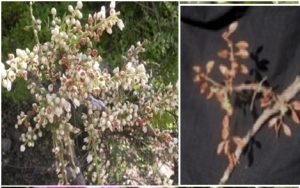|
Division
|
Angiosperms |
|
Class
|
Dicotledons |
|
Subclass
|
Polypetalae |
|
Series |
Disciflorae |
|
Order |
Geraniales |
|
Family |
Burseraceae |
|
Genus |
Boswellia |
|
Species |
serrata |

|
Etymology: |
Name in honour of John Browallius ( 1707-55 ) Bishop of Abo, a Sweedish botanist. |
|
Botanical name:
|
Boswellia serrata Roxb. ex Colebr. |
|
Local/Trade names: |
Salaigugal; Salla; Salar; Salai; Olibanum Tree |
|
Conservation status: |
Commonly found in dry hill slpoes. |
|
Digonestic features: |
Bark ash coloured, pealing off in flakes. |
|
Description: |
Decidous trees; branches pubescent; bark ash – coloured, peeling off in flakes. Leaves crowded at the ends of branches , alternate, imparipinnate, 20 – 32 cm long; leaflets 8 – 15 pairs, sub – opposite, sessile, lanceolate to linear, 2.5 – 7 x 0.6 – 1.6 cm , serrate, unequal sided, tip rotund or sometimes mucronate. Flowers small, white, in axillary or sub – terminal, fascicled racemes. Fruits tardily dehiscent, 3 – gonous capsules. |
|
Phenology: |
Fls.: March – May; Frts.; June – July. |
|
Distribution: |
Western Himalaya, outer hills, Central and South India, tropical Africa. |
|
Where to see it: |
Medicinal Plant Garden. |
|
Uses: |
Wood used for making newsprint and other types of paper. Also used for plywood, veneers, hard boards, cheap furniture, packing-cases, boat-masts, toys, and sheaths of knives, and for carving. Ammunition boxes made from this wood are better than those from teak. The species is the only non-coniferous source of turpentine and rosin in India. Tree exudes oleo-gum-resin called Indian olibanum or Indian Frankincense; also known as Luban or Salai guggal, chiefly used as incense. The volatile oil, obtained from oleo-gum-resin similar to turpentine oil and can be substituted for the later. Varnish prepared from it is quicker in drying than that prepared from ordinary commercial turpentine, but is less lustrous. Rosin may be used for making a substitute of Canada Balsam and micro-oil (oil-immersion); also used in high grade paints, varnishers, lacquers, and printing inks. Oleoresin free gum is used in calico-printing and textile industry for sizing and finishing; also employed in distempers. Gum may also be a source of furfural, used in the manufacture of nylon, plastics, etc. Bark used against diarrhoea and skin troubles. Gum considered expectorant, diuretic, and stomachic, and used in diarrhoea and dysentery, pulmonary affections and cutaneous troubles. Flowers and seeds eaten. |
Chief Conservator of Forests & Chief Wildlife Warden is the Head of the Department. There is one post of Conservator of Forests & two posts of Deputy Conservator of Forests viz.